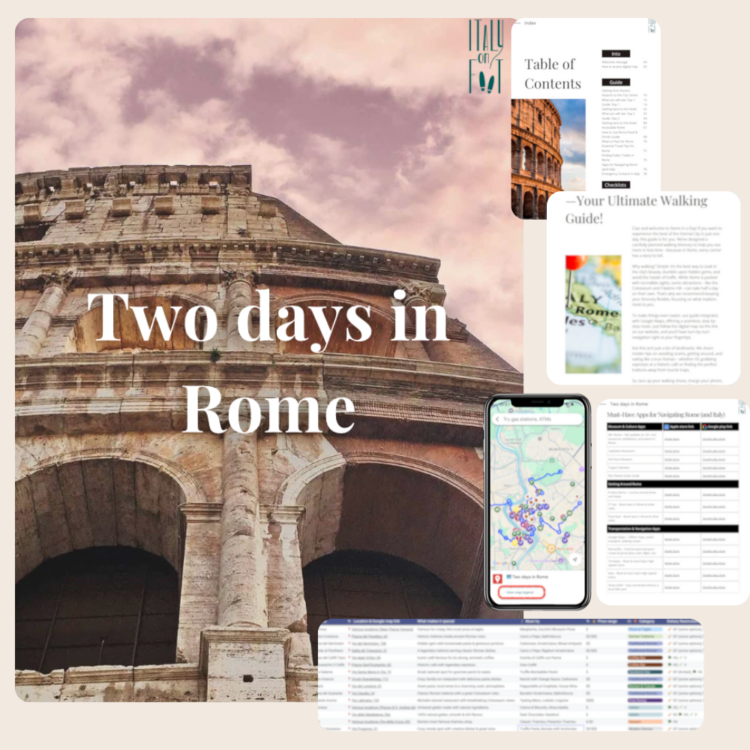When it comes to unparalleled culinary experiences, the food in Italy stands out as a beacon of tradition, taste, and cultural richness. Italy, with its diverse regions, offers a variety of flavors that are as distinct as the landscapes from where they originate. For those looking to discover the genuine heart and soul of Italian cuisine, a comprehensive guide awaits at Italy on Foot offering insights into not just the food but the very essence of traveling through Italy.
A Journey Through Regional Flavors
Italian cuisine illustrates a story of regional diversity, with each area showcasing its unique ingredients, cooking methods, and ancestral recipes. This county’s culinary map is as vast as its history, stretching from the sun-kissed shores of Sicily to the Alpine borders of Valle d’Aosta. Here, we’ll take you through a gastronomic tour of each region, highlighting traditional dishes that are a must-try for any food enthusiast.
Abruzzo
Abruzzo serves as a fascinating starting point with its rustic and earthy flavors. Arrosticini, succulent skewers of lamb, are a true representation of this region’s love for simple yet flavorful ingredients. Another gem is Maccheroni alla chitarra, a pasta dish that gets its name from the guitar-like instrument used to cut the pasta, offering a uniquely textured experience when paired with a hearty meat sauce.
Basilicata
In Basilicata, the cuisine reflects the rugged landscape and the hard-working nature of its people. Lucanica, an ancient recipe of spiced pork sausage, highlights the region’s rich history and culinary heritage. Meanwhile, Pane di Matera, a bread with a distinctive crust and soft interior, tells the story of traditional baking methods passed down through generations.
Calabria
The heat of Calabria is mirrored in its spicy dishes, most notably the ‘Nduja sausage, a fiery and spreadable pork salumi that encapsulates the bold character of Southern Italy. Tropea onions, sweet and robust, offer a counterbalance, showcasing the region’s agricultural excellence. They are best enjoyed in a simple salad or as a condiment, bringing a burst of freshness to every dish.
Campania
Campania is often heralded as the birthplace of pizza, with Naples standing proud as the custodian of the original Pizza Margherita. Yet, the region’s culinary repertoire extends beyond this famed dish. Mozzarella di Bufala, with its creamy texture and delicate flavor, epitomizes the art of cheesemaking in the area. Meanwhile, the Amalfi Coast offers an abundance of seafood dishes, each telling a tale of the Mediterranean’s bounty.
Emilia-Romagna
Emilia-Romagna, renowned for its gastronomic contributions, is a treasure trove of culinary delights. Parmigiano Reggiano and Prosciutto di Parma are among the world-renowned products originating from this region. However, it’s the less internationally known Tagliatelle al Ragù, a dish that goes beyond the misnamed ‘spaghetti bolognese,’ offering a deep dive into the authentic flavors cherished by locals.
Friuli-Venezia Giulia
This region brings a fusion of Italian, Austro-Hungarian, and Slavic flavors, creating a rich tapestry of culinary diversity. Frico, a crispy pancake made from potatoes and cheese, offers a comforting taste of rural tradition. Meanwhile, the San Daniele prosciutto, with its sweet and delicate flavor, showcases the finesse of Italian charcuterie.
Lazio
Home to the capital city, Rome, Lazio offers dishes that are steeped in history and tradition. Carbonara, a creamy pasta dish made with eggs, Pecorino cheese, pancetta, and pepper, has found fame worldwide but tastes distinctly authentic when savored in its hometown. Similarly, Artichokes Roman-style, braised with herbs and garlic, highlight the region’s agricultural richness.
Liguria
Liguria, with its picturesque coastlines, offers a cuisine that speaks of the sea and the mountains. Pesto Genovese, a basil-infused sauce, combines the freshness of the Ligurian hills with the richness of Parmigiano and Pecorino cheeses. Meanwhile, Focaccia di Recco, a thin and crispy bread filled with creamy Stracchino cheese, offers a glimpse into the ingenious simplicity of Italian baking.
Lombardy
Lombardy’s cuisine is influenced by its position in the heart of the Italian lakes and the Alps. Risotto alla Milanese, with its golden saffron hues, offers a creamy and comforting dish that pairs perfectly with Ossobuco, a slow-cooked veal shank that exemplifies the region’s love for hearty, warming dishes.
Marche
Marche, with its rolling hills and coastal plains, presents a varied menu of both land and sea. Brodetto di Pesce, a rich and aromatic seafood stew, encapsulates the flavors of the Adriatic. Olive all’ascolana, deep-fried olives stuffed with meat, offer a delicious insight into the region’s inventive and robust flavors.
Molise
Molise, Italy’s hidden gem, offers culinary traditions that are as authentic as they are ancient. Cavatelli, small pasta shells served with a hearty meat sauce or a fresh vegetable ragu, embody the simplicity and richness of Molisano cuisine. Pampanella, a spicy pork dish slow-rooked until tender, showcases the region’s skill in elevating simple ingredients to extraordinary delights.
Piedmont
Piedmont, bordering France and Switzerland, presents a cuisine that’s rich in flavors and sophistication. Truffles, especially the prized White Alba Truffles, offer an earthy and luxurious addition to dishes such as Risotto al Tartufo. Bagna càuda, a warm dip made from garlic, anchovies, olive oil, and butter, serves as a communal dish that brings together the love for sharing and feasting.
Puglia
Puglia, the heel of Italy’s boot, is blessed with abundant sunshine that ripens tomatoes, olives, and grapes to perfection. Orecchiette with Broccoli Rabe embodies the simplicity and freshness of Pugliese cuisine, while Burrata, a luscious and creamy cheese, offers a taste of the region’s dairy artistry.
Sardinia
Sardinia, an island with a rich pastoral heritage, offers dishes that speak of its history and landscape. Porceddu, roasted suckling pig, is a celebratory dish that encapsulates the island’s love for feasting and family gatherings. Pane carasau, a thin and crispy bread, accompanies every meal, symbolizing the islanders’ resourcefulness and connection to the land.
Sicily
Sicily, a crossroads of civilizations, presents a cuisine that’s as vibrant and diverse as its history. Arancini, stuffed rice balls coated in breadcrumbs and deep-fried, offer a glimpse into Sicily’s street food culture, while Cannoli, a sweet ricotta-filled pastry, embodies the island’s love for indulgent desserts.
Trentino-Alto Adige
Here, the influence of neighboring Austria is apparent in dishes like Canederli, bread dumplings served in broth or with butter, and Speck, a smoked and cured ham that reflects the region’s alpine environment. This cuisine blends Italian warmth with Northern European precision.
Tuscany
Tuscany is synonymous with robust flavors and traditional cooking. Florentine Steak, a large T-bone steak grilled to perfection, celebrates the region’s cattle farming heritage. Panzanella, a bread salad made with tomatoes, cucumbers, red onion, and basil, showcases the Tuscan knack for transforming simple ingredients into sumptuous meals.
Umbria
Umbria, known as the green heart of Italy, offers a cuisine that’s deeply connected to the land and its seasons. Black Truffles are a prized ingredient, adding depth and aroma to pasta and risotto dishes. Wild boar stew, slow-cooked with vegetables and herbs, encapsulates the wild and pristine nature of this region.
Valle d’Aosta
In the shadow of the Alps, Valle d’Aosta’s cuisine offers comforting warmth against the cold. Fonduta, a fondue made with Fontina cheese, bread, and eggs, provides a creamy and indulgent dip, while Polenta, served with rich stews or cheeses, exemplifies the simplicity and sustenance of mountain food.
Veneto
Veneto’s culinary landscape is as diverse as its territory, from the seafood-rich dishes of Venice to the hearty fare of the Dolomites. Risotto al Nero di Seppia, squid ink risotto, offers a dramatic and flavorful taste of the lagoon, while Tiramisu, arguably Italy’s most famous dessert, invites indulgence with its layers of espresso-soaked ladyfingers and mascarpone.
Throughout this journey from the snow-capped Alps to the sunny Mediterranean, it is clear that the food in Italy is a testament to the country’s rich cultural tapestry and steadfast commitment to culinary excellence. Each region, with its unique flavors and traditions, represents a vital piece of Italy’s gastronomic puzzle. Italian cuisine, steeped in history and embraced by generations, continues to be a source of national pride and a compelling reason for food lovers worldwide to explore this beautiful country. Whether it’s the classic elegance of a Florentine steak or the rustic charm of Abruzzo’s arrosticini, Italy offers a dish to captivate every palate, making it a true epicurean paradise.



